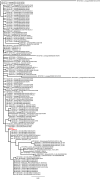Norovirus outbreak in a natural playground: A One Health approach
- PMID: 32037743
- PMCID: PMC7318310
- DOI: 10.1111/zph.12689
Norovirus outbreak in a natural playground: A One Health approach
Erratum in
-
Corrigendum.Zoonoses Public Health. 2022 Feb;69(1):71. doi: 10.1111/zph.12867. Zoonoses Public Health. 2022. PMID: 34967135 Free PMC article. No abstract available.
Abstract
Norovirus constitutes the most frequently identified infectious cause of disease outbreaks associated with untreated recreational water. When investigating outbreaks related to surface water, a One Health approach is insightful. Historically, there has been a focus on potential contamination of recreational water by bird droppings and a recent publication demonstrating human noroviruses in bird faeces suggested this should be investigated in future water-related norovirus outbreaks. Here, we describe a One Health approach investigating a norovirus outbreak in a natural playground. On social media, a large amount of waterfowl were reported to defecate near these playground premises leading to speculations about their potential involvement. Surface water, as well as human and bird faecal specimens, was tested for human noroviruses. Norovirus was found to be the most likely cause of the outbreak but there was no evidence for transmission via waterfowl. Cases had become known on social media prior to notification to the public health service underscoring the potential of online media as an early warning system. In view of known risk factors, advice was given for future outbreak investigations and natural playground design.
Keywords: One Health; birds; faeces; norovirus; social media; water.
© 2020 The Authors. Zoonoses and Public Health published by Blackwell Verlag GmbH.
Conflict of interest statement
None.
Figures



References
-
- Elmberg, J. , Berg, C. , Lerner, H. , Waldenstrom, J. , & Hessel, R. (2017). Potential disease transmission from wild geese and swans to livestock, poultry and humans: A review of the scientific literature from a One Health perspective. Infection Ecology and Epidemiology, 7(1), 1300450 10.1080/20008686.2017.1300450 - DOI - PMC - PubMed
Publication types
MeSH terms
LinkOut - more resources
Full Text Sources
Medical

